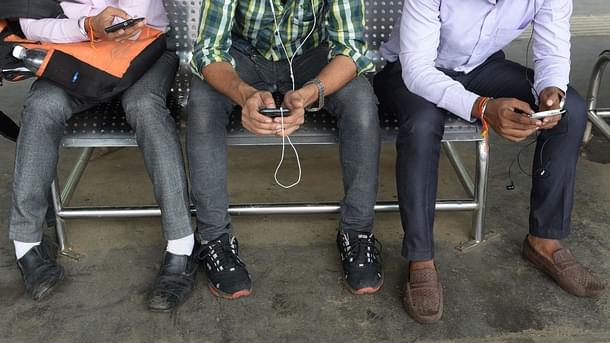Business
Telcos May Have Shunned Common Sense In Reckless Race for Spectrum
Sindhu Bhattacharya
Oct 10, 2016, 05:55 PM | Updated 05:55 PM IST
Save & read from anywhere!
Bookmark stories for easy access on any device or the Swarajya app.


Have India’s debt-ridden telecom companies (telcos) done themselves a favour by shunning the expensive 700 MHz spectrum band, on offer at exorbitant prices in the recently concluded auction, while preferring to splurge on other less expensive spectrum bands?
Not really. From the looks of it, the telcos have once again put aside common sense, placed bids for other spectrum bands which are simply not sustainable vis-à-vis their current balance sheet strength and may yet regret their recklessness.
It is true that bids placed were at just about 4 to 5 per cent premium over the reserve price or the base price for spectrum available in various bands, but even then, large sums spent on acquiring spectrum will stretch balance sheets further. As for the most efficient 700 MHz band, it is widely believed that the government may lower prices in the near future and hold yet another auction. But till it does, should the industry have purchased as much spectrum as it did in other bands, at the price bands the spectrum was pegged at?
Bharti Airtel placed bids worth Rs 14,200 crore, Vodafone India placed bids worth Rs 20,300 crore, Idea Cellular will spend Rs 12,800 crore whereas new entrant Reliance Jio placed bids worth Rs 13,700 crore during the latest auctions. Not all the money has to be paid upfront but it surely needs to be raised through debt in most cases.
Why did telecom companies bid aggressively in these auctions when, for the first time since the government decided to offer spectrum through auctions, they were under no pressure to buy airwaves for licence renewal? In the two auctions in 2015, they had little choice. Licences of Airtel, Vodafone, Idea and Reliance Communications (Rcom) in many of their existing operational circles were coming up for renewal in 2015 and 2016 and the operators did not have sufficient fall-back spectrum in 1800 MHz band in many of those circles. Had they not bought expensive 900 mhz band in these circles last year, they would have had to shut down 2G operations in those circles where they failed to retain airwaves.
This time, the big three telcos were not facing issues of survival in key markets. What perhaps drove them to recklessness was the looming threat of Jio and the potential for market disruption through 4G services.
Remember, prior to the auctions, the incumbents Airtel, Vodafone and Idea had all been waging a bitter war with Jio over interconnection issues and pricing of Jio’s data services, while also getting psyched over the new entrant’s free voice offer. It would appear that the big three participated in these auctions to get as much bandwidth for 4G services as possible, throwing caution to the winds.
Take the 2300 MHz band, for example. According to analysts at Edelweiss, telcos evinced strong interest in this spectrum band as the ecosystem has matured over the past five years and no new spectrum came for auction in that period. However, RJio and Bharti bid aggressively to enhance their holdings in this band, compelling Idea and Vodafone to also acquire spectrum in this band. “Consequently, Jio, Bharti and Idea acquired 2300 MHz spectrum in 16, 13 and 3 circles, respectively. Capacity spectrum purchases were imperative for sustaining competitive edge in leadership circles,” Edelweiss analysts noted.
There were aggressive bids by telcos in the 2500 MHz band too – where the ecosystem (including compatible devices) is yet to develop, all for the sake of staying ahead of competition. But competitive intensity meant not just reckless spectrum purchase for telcos – going forward, it also means enhanced capex and more spends on customer acquisition.
As this article points out, India’s telecom industry already has over Rs 3,80,000 crore of debt on its books and the current auction will surely take it past the Rs 4,00,000 crore mark. And while debt is forcing consolidation in the industry, which is a good outcome, the mounting debt pile remains a worry. Reserve Bank of India Governor Urjit Patel has already included telecom in the list of the five most stressed sectors for bank lending.
In a note to clients, Sunil Tirumalai and Viral Shah of Credit Suisse Equity Research said: “We have yet to see final circle wise details, but both operators [Bharti Airtel and Idea] claim to have substantially strengthened their footprints. Post the auctions, the leverage levels for the companies will rise to 2.9/4 net-debt/EBITDA [earnings before interest, taxes, depreciation and amortization], respectively – making these amongst the most leveraged telcos in the region. Recall that prior to the auctions both operators had assured that their bidding would only be selective: it appears to us that competitive compulsions have forced more aggressive bidding.” In other words, Bharti and Idea (more specifically Idea) will be increasing the pressure on their balance sheets significantly because of irrational bidding during these auctions leading to more debt.
Analysts at Kotak Institutional Equities expressed surprise at Idea’s aggressive bidding in these auctions – the company bought spectrum in 1800 MHz, 2100 MHz, 2300 MHz and 2500 MHz bands. Idea claims that it now has mobile broadband (3G or 4G) footprint across all 22 circles, with 3G capability in 15 circles and 4G capability in 20. “We also understand that the company now has 4G capacity spectrum in as many as 16 circles. We are a bit surprised by the company’s bids in the 2500 MHz band, especially given the lack of a mature device ecosystem; we will have to wait and watch how things evolve here. Also, Idea’s spectrum purchases in this auction are a clear indicator of the company not backing away from its pan-India ambitions even as the challenges of doing so on the current balance sheet strength were evident in the choices made.”
In the end, sustained competitive intensity may do more harm than good to India’s telecom sector. One positive effect of cut throat competition has been consolidation in the industry, which has already begun. But increasing debt to funds spectrum buys, more spends on customer acquisition and retention will no doubt make any sort of profitable growth for the sector more elusive than ever.
Sindhu Bhattacharya is a senior journalist.





